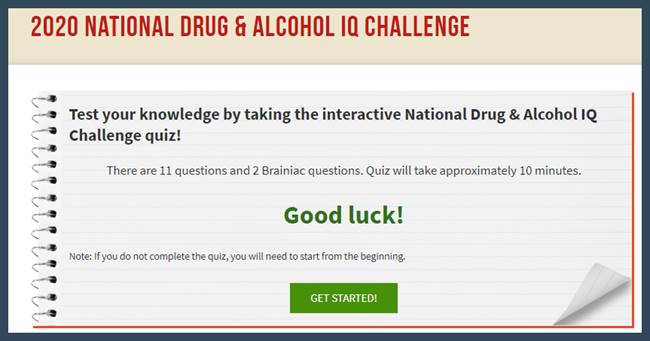
Supported by EVERFI
Let’s Practice:
Interactive Challenge
Marijuana:
The Basics
Marijuana is the most commonly
used illegal drug in the United
States. There is growing scientific evidence that heavy, regular use of
marijuana that begins during the teen years may lower a person’s IQ and
interfere with other aspects of functioning and well-being. Between 1990 and
2010, marijuana usage decreased. Since 2010 however, marijuana usage has been
increasing. This is mainly due to teens’ misconception that marijuana is not
harmful.
Marijuana is
a drug that is made from dried parts of the Cannabis sativa (hemp) plant.
It is consumed in a variety of ways:
·
It is most commonly rolled
into a cigarette called a “joint.”
·
Can be brewed in tea, or
mixed into different foods (ex. brownies)
It is a psychoactive drug, which means it
alters your mental state. The main
psychoactive ingredient in the Cannabis plant is delta-9-tetrahydro-cannabinol
or THC. There are over 500 additional drugs in the
plant.
Health
Effects
Marijuana
affects brain cell receptors that are critical to the growth and development of
the brain and its many functions. This causes many mental and physical side
effects.
Can result
in negative consequences with:
·
School
·
Sports
·
Driving
·
Short-term mental &
physical functions
·
Long-term mental &
physical functions
|
Effects
of Marijuana |
||
|
School |
· Difficulty processing and storing new information · Impairs ability to pay attention and complete complex tasks
that require focus and concentration · For frequent users of marijuana, these effects can last even
after the high is long gone. That can make it harder for users to do well in
school |
|
|
Sports |
· Lose the ability to control the timing · Lose control of movement · Weakens hand-eye coordination |
|
|
Driving |
· Marijuana significantly impairs judgment, motor coordination,
and reaction time · The risk of being involved in a car accident nearly doubles
after marijuana use · Studies have found a direct relationship between blood THC
concentration and impaired driving ability |
|
|
Short-Term |
· Impaired body movement and lowered reaction time · Sense distortion · Uncontrollable changes in mood |
|
|
Long-Term |
· Increased heart rate · Suppression of the immune system · Reduced cognitive ability |
|
Click here to watch the VIDEO.
Gateway Drug
Marijuana is
referred to as a “gateway drug.”
This means that people who use marijuana are more likely to try other drugs as
well. Other examples of gateway drugs are cigarettes & alcohol.
While not
everyone who uses marijuana will transition to using heroin or other drugs,
people who use marijuana also consume more legal and illegal drugs than people
who do not use marijuana.
·
Marijuana use is positively
correlated with alcohol use and cigarette use, as well as illegal drugs like
cocaine and methamphetamine
·
The vast majority of cocaine
users (99.9%) began by first using a “gateway drug.”
·
One study found that youth
(12 to 17 years old) who use marijuana are 85 times more likely to use cocaine
than kids who do not use pot.
Marijuana
can lead users to consume more potent drugs to achieve the same or more intense
high because tolerance builds up as they smoke more and more. There is ample
evidence that early initiation of marijuana use primes the brain for enhanced
later responses to other drugs. Drug dealers often lace blunts with cocaine,
crack, PCP, or even embalming fluid. It is hard to know for sure that the marijuana
you are using is relatively safe and won’t harm you. PCP, a powerful hallucinogen, is also
sometimes combined with marijuana to enhance its effects, or intensify the high. PCP is a dangerous drug and can lead to
violent behavior, severe seizures from hallucinations, and even death. Laced
marijuana can cause psychological dangers like hallucinations, euphoria, panic,
and rage.
Laws
It’s your
responsibility to know what is legal
and illegal in your state. Even if your state has passed legislation to
legalize marijuana, that does not mean you can use it freely!
·
You still must be 21 in all
(legal) states to consume marijuana
·
Amounts are regulated, so
even if you are of age in a legal state, you can be charged, jailed, and fined
if you have more than the legal limit of marijuana.
·
Regardless of whether you are
in a state where possession and consumption are legal, if the land you are
smoking on is federal land, you will be severely charged.
Laws on
marijuana vary significantly by state. Thus it is essential that you know and
understands your state’s regulation and consequences.
Click here to watch the VIDEO.
Takeaways
1. Marijuana is a
psychoactive drug that alters your mental state. The main ingredient is
THC.
2. There are a variety of long
& short term effects. Marijuana impacts many parts of daily life,
including school, sports, and driving.
3. Marijuana is addictive.
People who begin using cannabis as a teenager are more likely to get addicted
and experience withdrawal symptoms.
4. Marijuana is a gateway
drug, which means people who use marijuana are significantly more likely to use
and become addicted to other drugs.
5. Laws around marijuana possession and use vary from state to
state, and it is your responsibility
to be familiar with the laws and consequences for your state.
